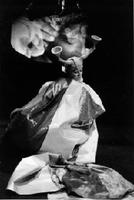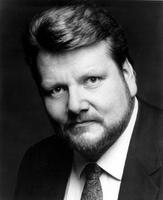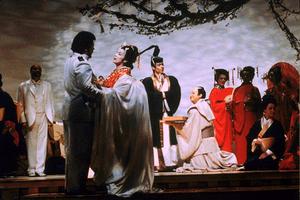Opera
In 1606 at Port Royal, the small and remote settlement on the Bay of Fundy, Le Théâtre de Neptune was played in boats on the water to welcome a returning expedition. This modest work of poetry with some musical interpolations initiated the drama with music in what would become Canada, but it would be another 200 years before fully formed opera would take root. Not until 1783 when the English opera by Charles Dibdin, The Padlock, was played in Québec City is there a definite record of an operatic performance. Montréal saw William Shield's The Poor Soldier in 1787, and 2 years later the founding of the Théâtre de Société provided a stage for plays and occasional operas, including Egidio-Romualdo Duni's Les Deux Chasseurs et la laitière in 1789. Halifax heard André Grétry's famous Richard Coeur-de-lion in 1798.Most of these and other performances were given by travelling troupes from the United States. Passage along and across Lake Ontario and the St. Lawrence, and up the eastern seaboard, connected the sparsely populated Canadian towns with the touring companies from the larger cities of the eastern US. In the early decades of the 19th century audiences became familiar with versions of popular works by Rossini, Donizetti, Bellini, Auber, and others then popular but now forgotten. These productions were invariably truncated versions arranged for easy touring, but in 1853 a company with orchestra, chorus and soloists under the direction of Luigi Arditi visited Québec, Montréal and Toronto and provided those cities with their first fully staged operatic performances. With the development of the railway at mid-century, a touring circuit was established from Windsor to Québec City that brought many companies and famous singers.
It was the railway that also carried opera to western Canada. The CPR built the Vancouver Opera House, which opened in 1891 with a performance of Wagner's Lohengrin. Winnipeg opened a large and elegant theatre in 1907 with the Canadian premiere of Puccini's new (1904) Madama Butterfly. And Edmonton was introduced to opera in 1909 with a visit from the Boston Grand Opera Company.
By the beginning of the 20th century most of the principal towns and cities had been visited by at least a modest operatic company, and Montréal and Toronto were sufficiently large to support regular visits by the companies that toured in the US. Many of the great singers of the day, in concert or in staged performances, visited Canada, among them John Braham, Henrietta Sontag, Adelina Patti, Jenny Lind, Emma Juch, Pasquale Brignoli, Anna Bishop, Teresa Parodi, Johanna Gadski, Lillian Nordica, Marcella Sembrich, Louise Homer and Lilli Lehmann. The establishment of indigenous performing companies, however, was slow to develop.
The First Canadian Companies
The Holman Juvenile Opera Troupe - a company headed by George and Harriet Holman with their children - visited Canada in 1848. They returned regularly over the next years, graduating to a regular company with daughters Julia and Sallie as the stars. In 1867 George Holman became lessee and manager of the Royal Lyceum in Toronto, where he installed his company to give both plays and operas. The Holmans continued to tour but remained the resident company in Toronto until 1873, when George moved to London (Ont) and changed the London Music Hall into the Holman Opera House. The company closed in 1888 following the death first of Sallie and then her father. The Holman Opera Company had included about 35 operas in its repertoire, ranging from Gounod's Faust and Weber's Der Freischütz to Offenbach's La belle Hélène and Gilbert and Sullivan's HMS Pinafore.
An enterprising attempt in Montréal to establish a company of international standards resulted in the Montreal Opera Company (1910-13) and its successor, the National Opera Company (1913- 14). Many outstanding singers and conductors appeared with the MOC and it toured as far as Toronto, Québec City, Ottawa and Rochester, NY, but it relied significantly on the private support of businessman Frank Meighen. It closed with heavy financial losses in 1913, and the NOC was unable to continue after the outbreak of the First World War.
Further attempts to establish a company in Toronto or Montréal resulted in only sporadic performances or short-lived companies. The exception was the Opera Guild of Montréal, which was founded in 1941 by Pauline Donalda and which in 28 seasons gave 33 productions of 29 works. After 1945 the economic and social changes in Canada began to make permanent companies feasible.
The ROYAL CONSERVATORY OF MUSIC in Toronto (until 1947 known as the Toronto Conservatory of Music) established an opera school in 1946 for the professional training of singers, the first school of such scope in Canada. A direct outgrowth of this was the Opera Festival Association, which presented a short season of 3 operas at the Royal Alexandra Theatre in 1950. The company flourished and became known as the CANADIAN OPERA COMPANY in 1958, when it began to send out a small touring company that traveled throughout Canada and sometimes into the United States. By the time it abandoned large-scale touring in 1990 it had given about 1500 performances outside Toronto. By 2000 the COC had produced 119 works in Toronto by 56 composers, making it the longest-lived and most substantial opera company in the country. For its first 25 years the COC was directed by Herman Geiger-Torel, the single most influential figure in Canadian opera during this period.
Contemporary Companies
By the year 2000 most cities had a regular company: Vancouver Opera Company (1959), Edmonton Opera Association (1963), Manitoba Opera Association (Winnipeg, 1969), Calgary Opera Association (1972), Pacific Opera Victoria (1978), OPÉRA DE MONTRÉAL (1980), Opera Hamilton (1980; since 1995 Opera Ontario in association with Kitchener-Waterloo), Opera Lyra (Ottawa, 1984), and Opéra du Québec (1984). Opera Atelier was formed in Toronto in 1985 by Marshall Pynkoski and Jeannette Zingg to give historical performances of 17th and 18th century operas, and in addition to local performances has visited the US, France and Japan. Opera in Concert, founded by Stuart Hamilton and also in Toronto, has since 1974 presented unusual and seldom-heard repertoire, usually with piano accompaniment. Major summer festivals that have included opera in their programs have been in Ottawa, Montréal, Banff, Guelph, Stratford and Vancouver.
Operatic Composition in Canada
The first original operatic work in Canada was Louis-Joseph-Marie QUESNEL's opéra comiqueColas et Colinette, performed in Montréal in 1790 and in 1805 and 1807 in Québec City. Although much of the score was lost, the orchestral accompaniment was reconstructed in 1963 by Godfrey Ridout and the work has been revived and recorded. Occasional attempts at composing grand opera in the 19th century had little success. By contrast, the operetta Leo, The Royal Cadet, composed by Oscar Telgman, became probably the most successful such work composed in Canada. Following its premiere in Kingston in 1889, it enjoyed about 150 performances up to 1925. It was revived by the Toronto Operetta Theatre in 1997 and in a fully restored version in 2001.
With the growth of performance organizations after 1945, composition of opera flourished in both conventional and radical forms. It is impossible to estimate the number of music theatre works that have been written since 1945, but there cannot be fewer than about 250, from among which only a few representative works are referred to here. The majority have been chamber operas. Among those that have had numerous performances are John BECKWITH's Night Blooimg Cereus (1958), Gabriel CHARPENTIER's An English Lesson (1968; one of a group of works lasting between 10 and 20 minutes), Jean VALLERAND's Le Magicien (1961), Nic Gotham's Nigredo Hotel (1992), and James Rolfe's Beatrice Chancy (1998). The first successful large-scale opera was Healey WILLAN's Deirdre, composed for CBC Radio in 1946 and given stage performances by the University of Toronto (1965), the COC (1966), and the BANFF CENTRE (1972). Harry SOMERS composed 6 operas (including one, A Midwinter Night's Dream, 1988, for performance by children) of which Louis Riel, commissioned by the COC, had dramatic impact at the premiere in Toronto in 1967, and subsequently in Montréal, Ottawa, Washington, again in Toronto, and on radio and television. This work, along with Mario and the Magician (1992), made Somers the most important composer of opera in Canada. Radical in concept and execution have been a series of works by R. Murray SCHAFER that were designed for performance in a variety of locations ranging from a wilderness lake at dawn to Union Station in Toronto at midnight, and the Ontario Science Centre from dusk to dawn. Among the untraditional stage pieces may be noted Claude VIVIER's widely performed Kopernikus (1980) and Alain Thibault's Ne blâmez jamais les Bédouins (1991) for solo soprano. A frankly popular musical style was the basis for André GAGNON's Nelligan (1990; text by Michel TREMBLAY), a commission by the Opéra de Montréal. A conservative but attractive musical idiom made Randolf Peters's commission from the COC, The Golden Ass (1999; text by Robertson DAVIES), a popular success.
The CBC Opera Company operated from 1948 to 1955 for studio broadcasts of full-length operas on radio, featuring Canadian singers in both popular and unusual repertoire. CBC Radio broadcasts the Saturday afternoon performances from the Metropolitan Opera House, New York, as well as performances from other Canadian and international companies. After the inception of television in 1952 there were irregular transmissions of opera, sometimes original CBC productions and sometimes those from other Canadian companies, mainly the COC.
Given its relatively small population, Canada has produced an astonishing number of operatic singers, beginning in the 19th century with Emma ALBANI and continuing in the 20th century with Edward JOHNSON, Louise Edvina, Pauline DONALDA, Jeanne Gordon and Raoul JOBIN. From 1950 to the present, many Canadians have regularly performed or continue to perform in Canada and in the great opera houses of the world, among them singers Léopold SIMONEAU, Pierrette ALARIE, André Turp, Louis QUILICO, Richard Verreau, Jon VICKERS, Joseph ROULEAU, Maureen FORRESTER, Cornelis Opthof, Bernard Turgeon, Victor Braun, Clarice Carson, Jean Bonhomme, Teresa STRATAS, Ermanno Mauro, Lillian Sukis, Claude Corbeil, Huguette Tourangeau, Paul FREY, Allan MONK, Maria Pellegrini, Judith FORST, Theodore Baerg, Richard MARGISON, Frances Ginzer, Gino QUILICO, Ben HEPPNER, Tracy DAHL, Gerald Finley, Adrianne Pieczonka, Michael Schade, Russell Braun, Gordon Gietz, Brett Polegato and Isabel Bayrakdarian; conductors Wilfrid PELLETIER, Mario BERNARDI and Yves Abel; and stage directors Irving Guttman, Sonja Frisell and Robert Carsen.

 Share on Facebook
Share on Facebook Share on X
Share on X Share by Email
Share by Email Share on Google Classroom
Share on Google Classroom




